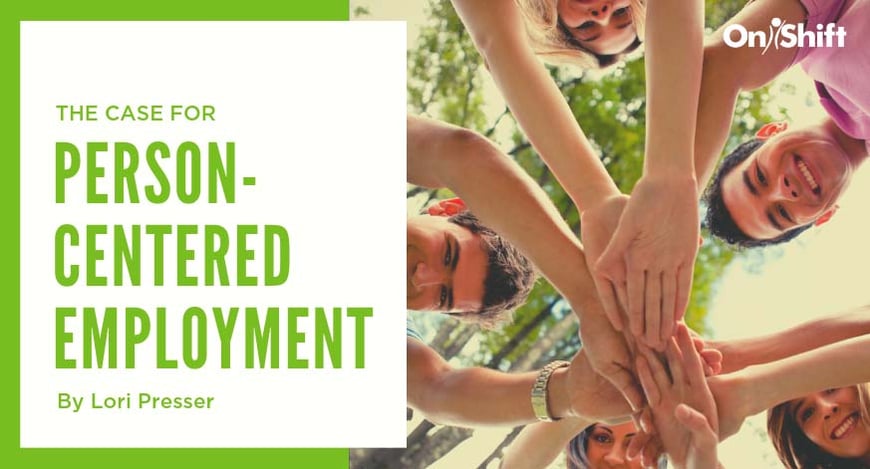
But before we can offer person-centered care, we need think about the people administering that care. None of the above is possible if this group is unhappy, disengaged and burnt out; and unfortunately, that is the case for many of today’s direct-care staff. That’s why I’d like to make the case for person-centered employment, where providers apply the same level of care and consideration they give each resident to each employee. Here are few ways to go about that, and in turn, provide better person-centered care and increase employee engagement.
Get To Know Employees On A Personal Level
A close peer of mine, Shelly Szarek-Skodny, CEO of Century Oak Care Center, uses the 3-fact method – where managers learn three personal facts about their employees. She says that when managers walk down the hall, they should be able to name them off the top of their head. I love this idea and in my former role as an executive director, I did something similar with employee profiles.
When an employee started, I would gather some simple facts about them -- their favorite soda, favorite candy, hobbies, etc. -- and keep them on file. Simply asking these questions helps you get to know your new hire on a personal level and helps you tailor how you reward and recognize them down the road.
Provide Work-Life Balance
One of the best ways to show employees you care is by providing work-life balance. Many caregivers today are juggling multiple jobs, caring for their family and handling other personal responsibilities. As much as we want to believe that their number one priority is their job at the community, that’s usually just not the case. Still, we have the opportunity to show them we care about them as people and value their commitments outside of work.
Management should offer consistent assignment and work with employees to create best-fit schedules. Doing so takes the guesswork out of their expected income and allows them to plan their life outside of work. It’s also been proven that consistent assignment leads to better care. Staff get to know the residents they regularly care for and notice changes in acuity or when something might be off.
Similarly, providing 24/7 access to schedules is a huge win. With OnShift’s mobile app, employees can swap shifts and pick up open shifts anytime, anywhere. This gives them a sense of control over their schedule, holds them accountable to when they work and helps to fill any staffing gaps.
Keep Communication Lines Open
Transparency is key. Employees should feel comfortable coming to management with any issues they may be experiencing, and management should do their part to keep employees informed and in the loop.
We’ve seen success with the pulse surveys in OnShift Engage, which are sent to employees every week or two weeks, asking them to rate their day on a scale. Additionally, they have the option to leave a comment to further elaborate, which can be sent anonymously if they don’t want to be identified. As a result, providers have seen an uptick in both the quantity and quality of feedback, which has helped them to identify areas for improvement and build on the culture at their community.
In lieu of traditional yearly performance reviews, OnShift Engage also provides easy-to-view performance dashboards. Managers can easily spot those employees that need coaching, and conversely, automatically distribute rewards to those doing excellent work.
Empower Your Employees
Today’s workforce wants to learn and grow in their careers. As a caregiver, I had my fair share of managers that I felt, for no reason at all, did not trust me, which was frustrating and left me feeling powerless. On the other hand, I had a few managers who were truly mentors to me. Those were the ones that inspired me, pushed me out of my comfort zone and got me to where I am in my career today.
The industry needs more of these managers, especially as they look to fill the shoes of the 70% of senior living CEOs expected to retire in the next ten years. You should also keep in mind that hiring within your organization is much less expensive than outsourcing. To grow leaders in your employee-base, empower them with career paths and learning opportunities, and never miss an opportunity to pass along your knowledge and expertise.
Take A Holistic Approach To Health & Wellness
I firmly believe that being a good caregiver starts with taking care of oneself. I used to tell my staff to do one thing for themselves every day. When you feel fulfilled outside of work, you tend to perform better at work. This self-care also extends to physical health. Providers should empower their employees to take care of themselves and educate them on how to do so. After all, happy employees lead to happy residents.
I do think that one of the biggest sources of stress for hourly employees, their finances, often goes overlooked. OnShift Wallet aims to relieve some of that stress by giving employees access to earned but unpaid wages between paychecks to better manage expenses. And the new OnShift® Wallet Visa® Prepaid Card gives employees an additional, convenient way to collect their earned wages and offers a direct deposit option to those without a bank account.
I hope you are able to put a few of these strategies into practice, so we as an industry can work toward offering person-centered employment for all the hardworking senior care staff out there. We owe it to them!
.png?width=600&name=Mid%20CTA%20How%20To%20Provide%20Person-Centered%20Employment%20For%20Better%20Person-Centered%20Care%20(1).png)